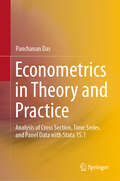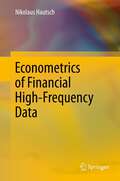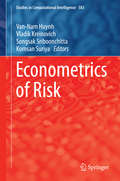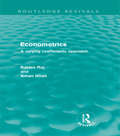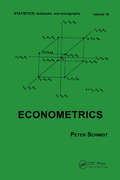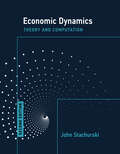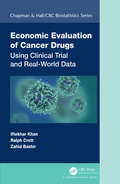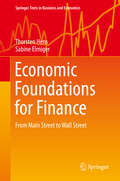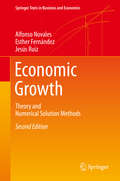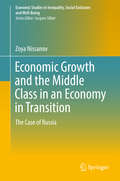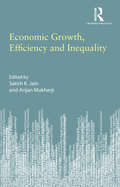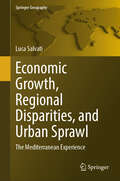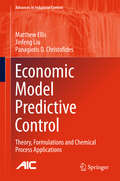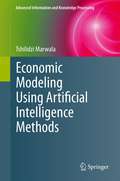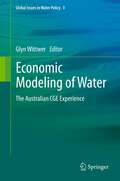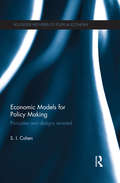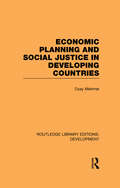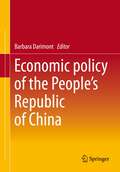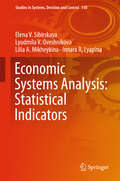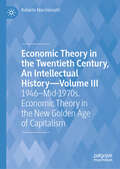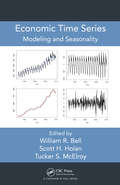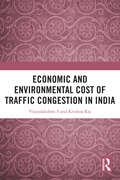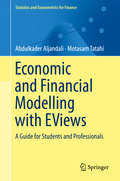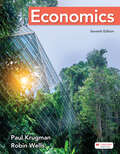- Table View
- List View
Econometrics in Theory and Practice: Analysis of Cross Section, Time Series and Panel Data with Stata 15.1
by Panchanan DasThis book introduces econometric analysis of cross section, time series and panel data with the application of statistical software. It serves as a basic text for those who wish to learn and apply econometric analysis in empirical research. The level of presentation is as simple as possible to make it useful for undergraduates as well as graduate students. It contains several examples with real data and Stata programmes and interpretation of the results. While discussing the statistical tools needed to understand empirical economic research, the book attempts to provide a balance between theory and applied research. Various concepts and techniques of econometric analysis are supported by carefully developed examples with the use of statistical software package, Stata 15.1, and assumes that the reader is somewhat familiar with the Strata software. The topics covered in this book are divided into four parts. Part I discusses introductory econometric methods for data analysis that economists and other social scientists use to estimate the economic and social relationships, and to test hypotheses about them, using real-world data. There are five chapters in this part covering the data management issues, details of linear regression models, the related problems due to violation of the classical assumptions. Part II discusses some advanced topics used frequently in empirical research with cross section data. In its three chapters, this part includes some specific problems of regression analysis. Part III deals with time series econometric analysis. It covers intensively both the univariate and multivariate time series econometric models and their applications with software programming in six chapters. Part IV takes care of panel data analysis in four chapters. Different aspects of fixed effects and random effects are discussed here. Panel data analysis has been extended by taking dynamic panel data models which are most suitable for macroeconomic research. The book is invaluable for students and researchers of social sciences, business, management, operations research, engineering, and applied mathematics.
Econometrics of Financial High-Frequency Data
by Nikolaus HautschThe availability of financial data recorded on high-frequency level has inspired a research area which over the last decade emerged to a major area in econometrics and statistics. The growing popularity of high-frequency econometrics is driven by technological progress in trading systems and an increasing importance of intraday trading, liquidity risk, optimal order placement as well as high-frequency volatility. This book provides a state-of-the art overview on the major approaches in high-frequency econometrics, including univariate and multivariate autoregressive conditional mean approaches for different types of high-frequency variables, intensity-based approaches for financial point processes and dynamic factor models. It discusses implementation details, provides insights into properties of high-frequency data as well as institutional settings and presents applications to volatility and liquidity estimation, order book modelling and market microstructure analysis.
Econometrics of Risk
by Van-Nam Huynh Vladik Kreinovich Songsak Sriboonchitta Komsan SuriyaThis edited book contains several state-of-the-art papers devoted to econometrics of risk. Some papers provide theoretical analysis of the corresponding mathematical, statistical, computational, and economical models. Other papers describe applications of the novel risk-related econometric techniques to real-life economic situations. The book presents new methods developed just recently, in particular, methods using non-Gaussian heavy-tailed distributions, methods using non-Gaussian copulas to properly take into account dependence between different quantities, methods taking into account imprecise ("fuzzy") expert knowledge, and many other innovative techniques. This versatile volume helps practitioners to learn how to apply new techniques of econometrics of risk, and researchers to further improve the existing models and to come up with new ideas on how to best take into account economic risks.
Econometrics: A Varying Coefficients Approach (Routledge Revivals)
by Baldev Raj Aman UllahOriginally published in 1981, this book considers one particular area of econometrics- the linear model- where significant recent advances have been made. It considers both single and multiequation models with varying co-efficients, explains the various theories and techniques connected with these and goes on to describe the various applications of the models. Whilst the detailed explanation of the models will interest primarily econometrics specialists, the implications of the advances outlined and the applications of the models will intrest a wide range of economists.
Econometrics: Microeconomics
by Peter Schmidt"A collection of proofs of fundamental theorems, this volume utilizes a format that is exhaustive and consistent. Every result covered in ``Econometrics''is proved as well as stated. One notation system is used throughout the volume. The topics included in the book cover such areas as estimations and testing in linear regression models under various sets of assumptions, and estimation and testing in simultaneous equations models. The latter subject is treated more extensively than in most econometrics books, and the entire volume is characterized by its rigorous level of examination. "
Economic Dynamics, second edition: Theory and Computation
by John StachurskiThe second edition of a rigorous and example-driven introduction to topics in economic dynamics that emphasizes techniques for modeling dynamic systems.This text provides an introduction to the modern theory of economic dynamics, with emphasis on mathematical and computational techniques for modeling dynamic systems. Written to be both rigorous and engaging, the book shows how sound understanding of the underlying theory leads to effective algorithms for solving real-world problems. The material makes extensive use of programming examples to illustrate ideas, bringing to life the abstract concepts in the text. Key topics include algorithms and scientific computing, simulation, Markov models, and dynamic programming. Part I introduces fundamentals and part II covers more advanced material. This second edition has been thoroughly updated, drawing on recent research in the field.New for the second edition: &“Programming-language agnostic&” presentation using pseudocode.New chapter 1 covering conceptual issues concerning Markov chains such as ergodicity and stability.New focus in chapter 2 on algorithms and techniques for program design and high-performance computing.New focus on household problems rather than optimal growth in material on dynamic programming.Solutions to many exercises, code, and other resources available on a supplementary website.
Economic Evaluation of Cancer Drugs: Using Clinical Trial and Real-World Data (Chapman & Hall/CRC Biostatistics Series)
by Iftekhar Khan Ralph Crott Zahid BashirCancer is a major healthcare burden across the world and impacts not only the people diagnosed with various cancers but also their families, carers, and healthcare systems. With advances in the diagnosis and treatment, more people are diagnosed early and receive treatments for a disease where few treatments options were previously available. As a result, the survival of patients with cancer has steadily improved and, in most cases, patients who are not cured may receive multiple lines of treatment, often with financial consequences for the patients, insurers and healthcare systems. Although many books exist that address economic evaluation, Economic Evaluation of Cancer Drugs using Clinical Trial and Real World Data is the first unified text that specifically addresses the economic evaluation of cancer drugs. The authors discuss how to perform cost-effectiveness analyses while emphasising the strategic importance of designing cost-effectiveness into cancer trials and building robust economic evaluation models that have a higher chance of reimbursement if truly cost-effective. They cover the use of real-world data using cancer registries and discuss how such data can support or complement clinical trials with limited follow up. Lessons learned from failed reimbursement attempts, factors predictive of successful reimbursement and the different payer requirements across major countries including US, Australia, Canada, UK, Germany, France and Italy are also discussed. The book includes many detailed practical examples, case studies and thought-provoking exercises for use in classroom and seminar discussions. Iftekhar Khan is a medical statistician and health economist and a lead statistician at Oxford Unviersity’s Center for Statistics in Medicine. Professor Khan is also a Senior Research Fellow in Health Economics at University of Warwick and is a Senior Statistical Assessor within the Licensing Division of the UK Medicine and Health Regulation Agency. Ralph Crott is a former professor in Pharmacoeconomics at the University of Montreal in Quebec, Canada and former head of the EORTC Health Economics Unit and former senior health economist at the Belgian HTA organization. Zahid Bashir has over twelve years experience working in the pharmaceutical industry in medical affairs and oncology drug development where he is involved in the design and execution of oncology clinical trials and development of reimbursement dossiers for HTA submission.
Economic Foundations for Finance: From Main Street to Wall Street (Springer Texts in Business and Economics)
by Thorsten Hens Sabine ElmigerThis book provides readers with essential concepts from financial economics for an integrated study of the financial system and the real economy. It discusses how long-term market prices are determined and affected by population growth, technological progress and non-renewable resources. The meaning of market prices is examined from the perspective of households and from the perspective of firms. The book therefore connects different fields of finance, which usually focus only on either the households’ side or the firms’ side.
Economic Growth
by Alfonso Novales Esther Fernández Jesús RuizThis is a book on deterministic and stochastic Growth Theory and the computational methods needed to produce numerical solutions. Exogenous and endogenous growth models are thoroughly reviewed. Special attention is paid to the use of these models for fiscal and monetary policy analysis. Modern Business Cycle Theory, the New Keynesian Macroeconomics, the class of Dynamic Stochastic General Equilibrium models, can be all considered as special cases of models of economic growth, and they can be analyzed by the theoretical and numerical procedures provided in the textbook. Analytical discussions are presented in full detail. The book is self contained and it is designed so that the student advances in the theoretical and the computational issues in parallel. EXCEL and Matlab files are provided on an accompanying website (see Preface to the Second Edition) to illustrate theoretical results as well as to simulate the effects of economic policy interventions. The structure of these program files is described in "Numerical exercise"-type of sections, where the output of these programs is also interpreted. The second edition corrects a few typographical errors and improves some notation.
Economic Growth and the Middle Class in an Economy in Transition
by Zoya NissanovThis book studies the evolution of the middle class in Russia after the fall of the Soviet Union. Using data from the RLMS (Russian Longitudinal Monitoring Survey), the volume covers the period of transition (1991-2008) during which many fundamental economic reforms were implemented. The first part of the book is devoted to a discussion of the concept of middle class and a description of the economic situation in Russia during the transition period. Particular attention is given to variations in the distribution of Russian incomes and the estimated importance of the middle class. The second part of the book focuses on the link between the middle class and income bipolarization. The third and last section of the book uses the semiparametric "mixture model" to discover how many different groups may be derived from the income distribution in Russia, as well as what the main socio-economic and demographic characteristics of those groups are. The mobility of households into and out of the middle class during the transition period is also studied in hopes of determining the factors that contribute to such mobility. Using rigorous empirical methods, this volume sheds light on a relatively unstudied economic group and provides insight for countries which are about to enter a transition period. As such, this book will be of great interest to researchers in economics and inequality as well as professionals and practitioners working with international organizations.
Economic Growth, Efficiency and Inequality
by Satish K. Jain Anjan MukherjiThis volume deals with a range of contemporary issues in Indian and other world economies, with a focus on economic theory and policy and their longstanding implications. It analyses and predicts the mechanisms that can come into play to determine the function of institutions and the impact of public policy.
Economic Growth, Regional Disparities, and Urban Sprawl: The Mediterranean Experience (Springer Geography)
by Luca SalvatiThis book gives a unique description of urban geography of Europe and specifically, Southern Europe, and provides a fine guide to urban complexity and resilience in the light of metropolitan sustainability. Sprawl is a multifaceted phenomenon that needs to be quantified with distinct measures and during an enough long observation period. Landscape change is recognized to be a relevant topic when studying the impact of urban growth and sprawl on peri-urban land. In the kaleidoscopic panorama of urban Europe, Mediterranean cities represent an element that breaks with the stereotypes of the 'old continent' urbanities. Originally developed according to a purely mono-centric structure, which grew radio-centrically with the progressive addition of satellite urban areas, Mediterranean cities have more recently oriented their growth path towards dispersed settlement models. This resulted in a high consumption of land, in contrast with the 'judicious compactness' that characterized the tumultuous development of the cities at least in the first three decades after World War II. This book tells, through narratives, photographs, qualitative-quantitative descriptions of landscapes, maps and indicators, the transition from a compact model—`judiciously mono-centric' and `land saving'—to contemporary sprawl, with practical implications in economic geography. The environmental, social and economic implications of this phenomenon, far from being a unique characteristic of the European Mediterranean region, have been also discussed, and the planning and policy implications addressed with respect to the individual ecological problems faced from time to time.
Economic Model Predictive Control
by Jinfeng Liu Panagiotis D. Christofides Matthew EllisThis book presents general methods for the design of economic model predictive control (EMPC) systems for broad classes of nonlinear systems that address key theoretical and practical considerations including recursive feasibility, closed-loop stability, closed-loop performance, and computational efficiency. Specifically, the book proposes: Lyapunov-based EMPC methods for nonlinear systems; two-tier EMPC architectures that are highly computationally efficient; and EMPC schemes handling explicitly uncertainty, time-varying cost functions, time-delays and multiple-time-scale dynamics. The proposed methods employ a variety of tools ranging from nonlinear systems analysis, through Lyapunov-based control techniques to nonlinear dynamic optimization. The applicability and performance of the proposed methods are demonstrated through a number of chemical process examples. The book presents state-of-the-art methods for the design of economic model predictive control systems for chemical processes. In addition to being mathematically rigorous, these methods accommodate key practical issues, for example, direct optimization of process economics, time-varying economic cost functions and computational efficiency. Numerous comments and remarks providing fundamental understanding of the merging of process economics and feedback control into a single framework are included. A control engineer can easily tailor the many detailed examples of industrial relevance given within the text to a specific application. The authors present a rich collection of new research topics and references to significant recent work making Economic Model Predictive Control an important source of information and inspiration for academics and graduate students researching the area and for process engineers interested in applying its ideas.
Economic Modeling Using Artificial Intelligence Methods
by Tshilidzi MarwalaEconomic Modeling Using Artificial Intelligence Methods examines the application of artificial intelligence methods to model economic data. Traditionally, economic modeling has been modeled in the linear domain where the principles of superposition are valid. The application of artificial intelligence for economic modeling allows for a flexible multi-order non-linear modeling. In addition, game theory has largely been applied in economic modeling. However, the inherent limitation of game theory when dealing with many player games encourages the use of multi-agent systems for modeling economic phenomena. The artificial intelligence techniques used to model economic data include: multi-layer perceptron neural networksradial basis functionssupport vector machinesrough setsgenetic algorithmparticle swarm optimizationsimulated annealingmulti-agent systemincremental learningfuzzy networksSignal processing techniques are explored to analyze economic data, and these techniques are the time domain methods, time-frequency domain methods and fractals dimension approaches. Interesting economic problems such as causality versus correlation, simulating the stock market, modeling and controling inflation, option pricing, modeling economic growth as well as portfolio optimization are examined. The relationship between economic dependency and interstate conflict is explored, and knowledge on how economics is useful to foster peace - and vice versa - is investigated. Economic Modeling Using Artificial Intelligence Methods deals with the issue of causality in the non-linear domain and applies the automatic relevance determination, the evidence framework, Bayesian approach and Granger causality to understand causality and correlation. Economic Modeling Using Artificial Intelligence Methods makes an important contribution to the area of econometrics, and is a valuable source of reference for graduate students, researchers and financial practitioners.
Economic Modeling of Water: The Australian CGE Experience
by Glyn WittwerThe book details the innovative TERM (The Enormous Regional Model) approach to regional and national economic modeling, and explains the conversion from a comparative-static to a dynamic model. It moves on to an adaptation of TERM to water policy, including the additional theoretical and database requirements of the dynamic TERM-H2O model. In particular, it examines the contrasting economic impacts of water buyback policy and recurring droughts in the Murray-Darling Basin. South-east Queensland, where climate uncertainty has been borne out by record-breaking drought and the worst floods in living memory, provides a chapter-length case study. The exploration of the policy background and implications of TERM's dynamic modeling will provide food for thought in policy making circles worldwide, where there is a pressing need for solutions to similarly intractable problems in water management.
Economic Models for Policy Making: Principles and Designs Revisited (Routledge Frontiers of Political Economy)
by Solomon CohenOver the past decades, many different kinds of models have been developed that have been of use to policy makers, but until now the different approaches have not been brought together with a view to enhancing the systematic unification and evaluation of these models. This new volume aims to fill this gap by bringing together four decades’ worth of work by S. I. Cohen on economic modelling for policy making. Work on older models has been rewritten and brought fully up to date, and these older models have therefore been brought back to the fore, both to assess how they influenced more recent models and to see how they could be used today. The focus of the book is on models for development policies in developing economies, but there are some chapters that relate to economic policies in transition and developed economies. The policy areas covered are of typical interest in developing and transition economies. They include those relating to trade liberalization reforms, sustainable development, industrial development, agrarian reform, growth and distribution, human resource development and education, public goods and income transfers. Each chapter contains a brief assessment of the empirical literature on the economic effects of the policy measures discussed in the chapter. The book presents a platform of economic modelling that can serve as a refresher for practising professionals, as well as a reference companion for graduates engaging in economic modelling and policy preparations.
Economic Planning and Social Justice in Developing Countries
by Ozay MehmetFirst published in 1978, this book was written at a time when belief was high in Western-guided economic development of the emerging countries. The success of Marshall Plan in war-torn Europe generated a US-led optimism that, with generous inflows of aid and technical assistance, the Third World could be won over in the Cold War. The author’s direct experience as a young academic economist in Cyprus, Malaysia, Uganda and Liberia led him to question this general optimism: the reality on the ground in the developing world did not seem to match Western optimism. Theories and blueprints, made in the West, did not fit the requirements of developing countries. Higher production and better income distribution were inseparable twin objectives of developing nations. That meant, production of a higher national output must at the same time promote social justice. Investment must create adequate jobs so that new entrants into rapidly expanding labor force could be gainfully employed. Yet, the dominant (Western) theories of development at the time, in particular the Trickle Down Theory of Growth, prescribed "Growth First, Distribution Later" strategy. Similarly, Import Substitution Industrialization theories were emphasized at the expense of export-led growth. Dualistic Growth theories preached urban-biased, anti-rural development. This book was written as a rebuttal of such faulty theorizing and misguided professional technical assistance and the book’s message is no less valid today than in the 1970’s.
Economic Policy of the People's Republic of China
by Barbara DarimontThis book deals with the current economic policy of the People's Republic of China. In addition to a brief overview of economic history since its founding and discussions of economic models, an overview of both the forms of business and the Chinese labor market is provided. The book pays particular attention to the development of China's e-commerce sector. Equally significant are China's environmental issues against the backdrop of the climate crisis. Without innovations, for example in energy production and waste management, the Chinese economy will hardly be able to continue growing. Therefore, one focus of the book is on economic policy in the environmental sector. Finally, foreign policy, including the Silk Road Initiative, is examined. The aim of this book is to highlight the above developments. It is aimed at laypersons involved in the business of China as well as first-year students who want an overview of economic policy institutions and current developments.
Economic Systems Analysis: Statistical Indicators (Studies in Systems, Decision and Control #158)
by Elena V. Sibirskaya Lyudmila V. Oveshnikova Lilia A. Mikheykina Innara R. LyapinaThis book explores a wide range of issues related to the methodology, organization, and technologies of analytical work, showing the potential of using analytical tools and statistical indicators for studying socio-economic processes, forecasting, organizing effective companies, and improving managerial decisions. At the level of “living knowledge” in the broad context, it describes the essence of analytical technologies and means of applying analytical and statistical work. The book is of interest to readers regardless of their specialization: scientific research, medicine, pedagogics, law, administrative work, or economic practice. Starting from the premise that readers are familiar with the theory of statistics, which has formulated the general methods and principles of establishing the quantitative characteristics of mass phenomena and processes, it describes the concepts, definitions, indicators and classifications of socio-economic statistics, taking into consideration the international standards and the present-day practice of statistics in Russia. Although concise, the book provides plenty of study material as well as questions at the end of each chapter It is particularly useful for those interested in self-study or remote education, as well as business leaders who are interested in gaining a scientific understanding of their financial and economic activities.
Economic Theory in the Twentieth Century, An Intellectual History—Volume III: 1946–Mid-1970s. Economic Theory in the New Golden Age of Capitalism
by Roberto MarchionattiThis book, set out over four-volumes, provides a comprehensive history of economic thought in the 20th century. Special attention is given to the cultural and historical background behind the development of economic theories, the leading or the peripheral research communities and their interactions, and a critical appreciation and assessment of economic theories throughout these times.Volume III addresses economic theory in the period of the new golden age of capitalism, between the years from the end of the Second World War to the mid1970s, which saw the establishment of the new mainstream, in particular in its Harvard-MIT-Cowles version. It was the period of the pre-eminence of the Neoclassical Keynesian Synthesis—the theoretical core of the period’s dominant school of thought.This work provides a significant and original contribution to the history of economic thought and gives insight to the thinking of some of themajor international figures in economics. It will appeal to students, scholars and the more informed reader wishing to further their understanding of the history of the discipline.
Economic Time Series: Modeling and Seasonality
by Tucker S. McElroy Scott H. Holan William R. BellEconomic Time Series: Modeling and Seasonality is a focused resource on analysis of economic time series as pertains to modeling and seasonality, presenting cutting-edge research that would otherwise be scattered throughout diverse peer-reviewed journals. This compilation of 21 chapters showcases the cross-fertilization between the fields of time s
Economic and Environmental Cost of Traffic Congestion in India
by Krishna Raj Vijayalakshmi S SThis book explores one of the most prevailing problems of the contemporary urban world, i.e. traffic congestion and its economic, environmental, and health implications. Generally viewed as an urban menace, the problem of traffic congestion has huge economic implications, which are often overlooked by urban planners. This book examines and quantifies the costs and adverse consequences and of traffic congestion, which include emissions, loss of productive hours, fuel wastage, and the adverse effects on the health of commuters, among others. It provides a comprehensive and scientific understanding of the underlying problems of traffic gridlocks by analyzing empirical evidence from Bengaluru, a city in South India. It also offers solutions and highlights innovative measures that draw from both economic and engineering perspectives to counter and reduce the tangible and intangible costs of traffic conjestion. This book will be of interest to both academic and non-academic readers of economics, environmental economics and econometrics, transport economics, urban planning, transport geography, as well as planners and policy makers.
Economic and Financial Modelling with EViews: A Guide for Students and Professionals (Statistics and Econometrics for Finance)
by Abdulkader Aljandali Motasam TatahiThis practical guide in Eviews is aimed at practitioners and students in business, economics, econometrics, and finance. It uses a step-by-step approach to equip readers with a toolkit that enables them to make the most of this widely used econometric analysis software. Statistical and econometrics concepts are explained visually with examples, problems, and solutions.Developed by economists, the Eviews statistical software package is used most commonly for time-series oriented econometric analysis. It allows users to quickly develop statistical relations from data and then use those relations to forecast future values of the data. The package provides convenient ways to enter or upload data series, create new series from existing ones, display and print series, carry out statistical analyses of relationships among series, and manipulate results and output. This highly hands-on resource includes more than 200 illustrative graphs and tables and tutorials throughout. Abdulkader Aljandali is Senior Lecturer at Coventry University in London. He is currently leading the Stochastic Finance Module taught as part of the Global Financial Trading MSc. His previously published work includes Exchange Rate Volatility in Emerging Markers, Quantitative Analysis, Multivariate Methods & Forecasting with IBM SPSS Statistics and Multivariate Methods and Forecasting with IBM® SPSS® Statistics. Dr Aljandali is an established member of the British Accounting and Finance Association and the Higher Education Academy.Motasam Tatahi is a specialist in the areas of Macroeconomics, Financial Economics, and Financial Econometrics at the European Business School, Regent’s University London, where he serves as Principal Lecturer and Dissertation Coordinator for the MSc in Global Banking and Finance at The European Business School-London.
Economic and Political Change in Asia and Europe
by Frédéric Royall Bernadette Andreosso-O'CallaghanSince the 1973 publication of Alain Peyrefitte's prophetic When China Awakens, developments in East Asia have outstripped even the wildest predictions. China has undergone the fastest industrialization and urbanization process in history, yet tensions there are rising as some realize how far they have been left behind. This volume explores the applicability of European economic and social models to our analysis of East Asia's and, in particular, China's situation. Though millions of Chinese and other Asian people have been lifted out of poverty, inequality is rising nonetheless, and contemporary Europe and Asia are both witnessing collective action against rampant economic neoliberalism in the former and the exclusion of minorities in the latter. It is difficult to overstate the relevance of this assessment, which seeks answers to some central questions: Can events in Europe serve as a model for those in East Asia? Are there similarities or differences between the two regions? To what extent do political, economic or social systems stimulate or inhibit collective action? How culturally equivalent are the collective actions of marginalized/ disadvantaged people in the two locations, or are events in Europe symptomatic of specific cultural attributes? Comparing and contrasting the research tools and dominant paradigms in the social and economic sciences in East Asia and Europe, as this volume does, throws out some revealing results.
Economics
by Paul KrugmanAvailable with Achieve, Krugman and Wells’ widely adopted text helps students reach new levels of economic understanding. <P><P>The new edition is revised and enhanced, including new interactive graphs, interactive topic reviews, thorough coverage of the Covid recession, and updated analysis of aggregate demand/aggregate supply and monetary policy.
